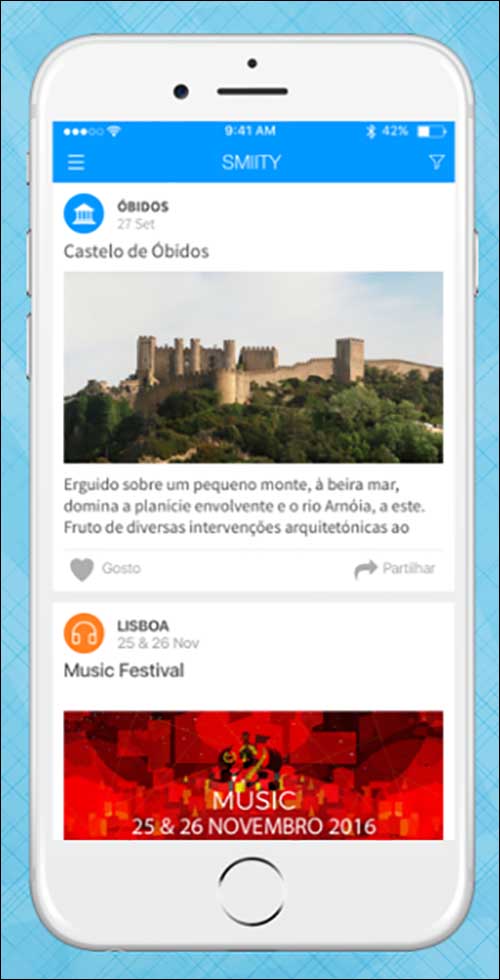Jan 05, 2017Mobile software and app services company Mobinteg has deployed a Bluetooth Low Energy (BLE) beacon-based solution within several cities and villages throughout Portugal and Italy, in order to connect app users with information about city buildings, businesses and historical monuments. The system, known as SMIITY (SMart Interactive cITY), connects app-using tourists with local history, events and attractions, as well as trail information in a mountainous hiking area. The company has also developed a device called the SMIITY Box, which senses air quality (such as the presence of carbon monoxide) and noise levels, and shares that data via a BLE or Wi-Fi connection.
Mobinteg was launched in Lisbon, Portugal, in 2012 as a mobile development services company, says founder Fernando Pinto. During the past few years, the firm has been looking into new technologies that would automatically put information about physical surroundings into the hands of smartphone users. "We think the smartphone serves as an extension of the human body," he says, and the company has thus been developing solutions for wearable devices to track the activities of athletes, as well as devices to monitor falls or activities of senior citizens with health issues.
Last year, Mobinteg began deploying its SMIITY solution for city governments. The first installation was in Óbidos, Portugal, a town featuring such historic sites as a town gate and castle, as well as specialty tourist-oriented stores and restaurants. The company has installed approximately 150 beacons around the community to date.
"This small village has a lot of stories to tell," Pinto says, and the SMIITY system is designed to help buildings and businesses tell that story according to a particular app user's interests. First, a visitor or resident downloads the app at either the Google Play or iTunes websites. If a person so chooses, he or she can link a social-network account, such as Facebook, to the app so that the SMIITY content-management software can then use that individual's interests to filter content specifically of his or her preferences. Users can also input their own interests.
As the individual moves around the city, beacons deployed on building walls, doorways and other structures transmit their ID numbers. The user's phone captures that information and accesses the relevant data for each location. This means that a person, upon passing an historic church, for instance, can view details about that building and its history. The individual can also receive a notification if he or she is interested in buying pastries and nears a business selling them.
Additionally, the app can provide general content, such as events taking place within the town and a map to reach the location of a selected event. Users can select their language of choice to receive that content.
The City of Elvas, Portugal, has installed the SMIITY system to provide information around town and in a large historic military fort. The fort posed unique challenges, Pinto says. The city wanted the fort to remain in its existing condition without the aesthetic distraction of signage, posters or digital monitors, he explains, but it also wanted tourists to view information about the structure. The solution consists of SMIITY's beacons installed at discreet locations around the fort. As individuals running the SMIITY app on their phones move around the premises, they can view content about their location at any given time. For instance, upon entering the prison cells, they can read about the prison's history, while the prison walls look exactly as they did while still in use. "The concept is for the fort to tell you a story," Pinto states. "What we really want is to help the people feel the environment" without signage in the way.
In Vali di Susa, Italy, a region of small villages is employing the beacon-based app to provide information about what is happing within each village. This includes the types of products being sold at restaurants and cafés.
In Lisbon, the system is installed around town and within the National Museum of Ancient Art. In that way, not only can visitors view the museum's location on the app, but once they enter, beacons installed on walls throughout the building enable the app to display content about specific exhibits. Even before entering, users can also employ the app to purchase tickets.
What's more, the SMIITY system is being used in Madeira, Portugal, to help hikers learn about the environment on hiking trails on its mountainous main island. Beacons are installed in trees, as well as on or behind rocks and at other locations, where they are not plainly visible. As individuals walk through the trails, their phones capture beacon transmissions, enabling them to view not only their location on the trail, but also information about the area's plants, geology and wildlife.
The SMIITY Box is now being tested in Portugal for use by municipalities to track air quality and noise conditions. The device includes a sensor that captures sound levels, counts people passing and measures the quality, temperature and humidity of the surrounding air. The municipality can then access that data in one of two ways. If a Wi-Fi network is available, the information can be forwarded to a server via a Wi-Fi connection, and Mobinteg's software can then interpret and display that data for the user. If no such network is available, however, the beacon technology can be used. In this case, those with a smartphone who have downloaded the SMIITY app can serve as the transmission provider. As they walk past the battery-powered beacon, their phone receives the transmission and the app prompts the phone to forward that data back to the server.
Mobinteg is currently in discussions with several communities about further testing this product, Pinto reports. In addition, the SMIITY system is expected to be installed in about 20 more communities around Europe this year. The company has opened an office in Atlanta, Ga., and plans to begin offering the technology in the United States as well.
Mobinteg uses its own beacons, Pinto says, which are manufactured by a third party to meet the company's requirements. They are able to transmit data about battery levels, he adds, along with their own identifier, and can pulse transmissions from the BLE iBeacon profile, then switch to Eddystone and back to iBeacon again. The beacons are also ruggedized for use outdoors.




